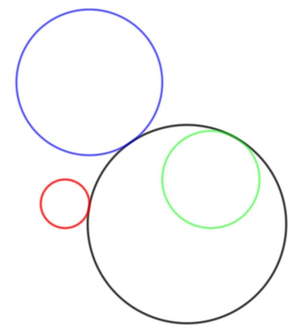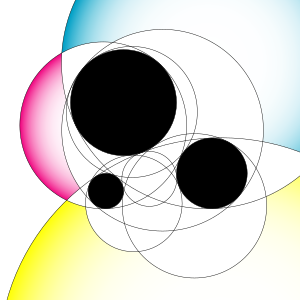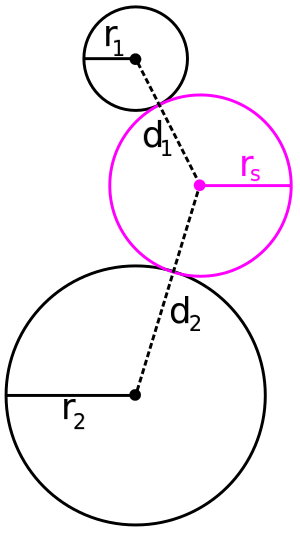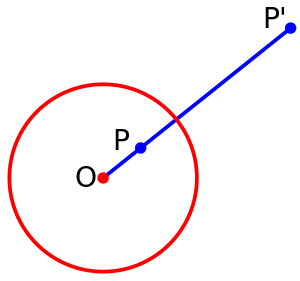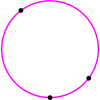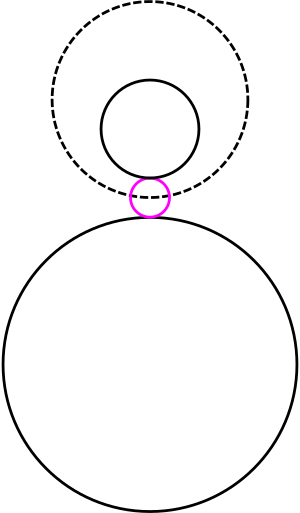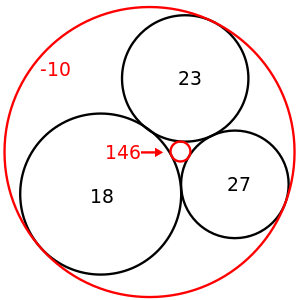مسألة أبولونيوس
في الهندسة الرياضية، مسألة أپولونيوس هي مسألة إنشاء دوائر مماسة لثلاث دوائر معلومة في المستوي. صاغ أپولونيوس من پرگا (ح. 262 ق.م. – ح. 190 ق.م.) هذه المسألة وحلها في أحد أعماله التي ضاعت، وعنوانه Ἐπαφαί (Epaphaí, "Tangencies"). but a 4th-century AD report of his results by Pappus of Alexandria has survived. Three given circles generically have eight different circles that are tangent to them (Figure 2), a pair of solutions for each way to divide the three given circles in two subsets (there are 4 ways to divide a set of cardinality 3 in 2 parts).
In the 16th century, Adriaan van Roomen solved the problem using intersecting hyperbolas, but this solution does not use only straightedge and compass constructions. François Viète found such a solution by exploiting limiting cases: any of the three given circles can be shrunk to zero radius (a point) or expanded to infinite radius (a line). Viète's approach, which uses simpler limiting cases to solve more complicated ones, is considered a plausible reconstruction of Apollonius' method. The method of van Roomen was simplified by Isaac Newton, who showed that Apollonius' problem is equivalent to finding a position from the differences of its distances to three known points. This has applications in navigation and positioning systems such as LORAN.
Later mathematicians introduced algebraic methods, which transform a geometric problem into algebraic equations. These methods were simplified by exploiting symmetries inherent in the problem of Apollonius: for instance solution circles generically occur in pairs, with one solution enclosing the given circles that the other excludes (Figure 2). Joseph Diaz Gergonne used this symmetry to provide an elegant straightedge and compass solution, while other mathematicians used geometrical transformations such as reflection in a circle to simplify the configuration of the given circles. These developments provide a geometrical setting for algebraic methods (using Lie sphere geometry) and a classification of solutions according to 33 essentially different configurations of the given circles.
Apollonius' problem has stimulated much further work. Generalizations to three dimensions—constructing a sphere tangent to four given spheres—and beyond have been studied. The configuration of three mutually tangent circles has received particular attention. René Descartes gave a formula relating the radii of the solution circles and the given circles, now known as Descartes' theorem. Solving Apollonius' problem iteratively in this case leads to the Apollonian gasket, which is one of the earliest fractals to be described in print, and is important in number theory via Ford circles and the Hardy–Littlewood circle method.
منطوق المسألة
بشكل عام أعطيت ثلاث دوائر على نفس السطح, هناك ثمانية دوائر مختلفة تمسها. وهذه الدوائر الثمانية هي حل مسألة أبولونيوس.
The general statement of Apollonius' problem is to construct one or more circles that are tangent to three given objects in a plane, where an object may be a line, a point or a circle of any size.[1][2][3][4] These objects may be arranged in any way and may cross one another; however, they are usually taken to be distinct, meaning that they do not coincide. Solutions to Apollonius' problem are sometimes called Apollonius circles, although the term is also used for other types of circles associated with Apollonius.
The property of tangency is defined as follows. First, a point, line or circle is assumed to be tangent to itself; hence, if a given circle is already tangent to the other two given objects, it is counted as a solution to Apollonius' problem. Two distinct geometrical objects are said to intersect if they have a point in common. By definition, a point is tangent to a circle or a line if it intersects them, that is, if it lies on them; thus, two distinct points cannot be tangent. If the angle between lines or circles at an intersection point is zero, they are said to be tangent; the intersection point is called a tangent point or a point of tangency. (The word "tangent" derives from the Latin present participle, tangens, meaning "touching".) In practice, two distinct circles are tangent if they intersect at only one point; if they intersect at zero or two points, they are not tangent. The same holds true for a line and a circle. Two distinct lines cannot be tangent in the plane, although two parallel lines can be considered as tangent at a point at infinity in inversive geometry (see below).[5][6]
The solution circle may be either internally or externally tangent to each of the given circles. An external tangency is one where the two circles bend away from each other at their point of contact; they lie on opposite sides of the tangent line at that point, and they exclude one another. The distance between their centers equals the sum of their radii. By contrast, an internal tangency is one in which the two circles curve in the same way at their point of contact; the two circles lie on the same side of the tangent line, and one circle encloses the other. In this case, the distance between their centers equals the difference of their radii. As an illustration, in Figure 1, the pink solution circle is internally tangent to the medium-sized given black circle on the right, whereas it is externally tangent to the smallest and largest given circles on the left.
Apollonius' problem can also be formulated as the problem of locating one or more points such that the differences of its distances to three given points equal three known values. Consider a solution circle of radius rs and three given circles of radii r1, r2 and r3. If the solution circle is externally tangent to all three given circles, the distances between the center of the solution circle and the centers of the given circles equal d1 = r1 + rs, d2 = r2 + rs and d3 = r3 + rs, respectively. Therefore, differences in these distances are constants, such as d1 − d2 = r1 − r2; they depend only on the known radii of the given circles and not on the radius rs of the solution circle, which cancels out. This second formulation of Apollonius' problem can be generalized to internally tangent solution circles (for which the center-center distance equals the difference of radii), by changing the corresponding differences of distances to sums of distances, so that the solution-circle radius rs again cancels out. The re-formulation in terms of center-center distances is useful in the solutions below of Adriaan van Roomen and Isaac Newton, and also in hyperbolic positioning or trilateration, which is the task of locating a position from differences in distances to three known points. For example, navigation systems such as LORAN identify a receiver's position from the differences in arrival times of signals from three fixed positions, which correspond to the differences in distances to those transmitters.[7][8]
History
A rich repertoire of geometrical and algebraic methods have been developed to solve Apollonius' problem,[9][10] which has been called "the most famous of all" geometry problems.[3] The original approach of Apollonius of Perga has been lost, but reconstructions have been offered by François Viète and others, based on the clues in the description by Pappus of Alexandria.[11][12] The first new solution method was published in 1596 by Adriaan van Roomen, who identified the centers of the solution circles as the intersection points of two hyperbolas.[13][14] Van Roomen's method was refined in 1687 by Isaac Newton in his Principia,[15][16] and by John Casey in 1881.[17]
Although successful in solving Apollonius' problem, van Roomen's method has a drawback. A prized property in classical Euclidean geometry is the ability to solve problems using only a compass and a straightedge.[18] Many constructions are impossible using only these tools, such as dividing an angle in three equal parts. However, many such "impossible" problems can be solved by intersecting curves such as hyperbolas, ellipses and parabolas (conic sections). For example, doubling the cube (the problem of constructing a cube of twice the volume of a given cube) cannot be done using only a straightedge and compass, but Menaechmus showed that the problem can be solved by using the intersections of two parabolas.[19] Therefore, van Roomen's solution—which uses the intersection of two hyperbolas—did not determine if the problem satisfied the straightedge-and-compass property.
Van Roomen's friend François Viète, who had urged van Roomen to work on Apollonius' problem in the first place, developed a method that used only compass and straightedge.[20] Prior to Viète's solution, Regiomontanus doubted whether Apollonius' problem could be solved by straightedge and compass.[21] Viète first solved some simple special cases of Apollonius' problem, such as finding a circle that passes through three given points which has only one solution if the points are distinct; he then built up to solving more complicated special cases, in some cases by shrinking or swelling the given circles.[1] According to the 4th-century report of Pappus, Apollonius' own book on this problem—entitled Ἐπαφαί (Epaphaí, "Tangencies"; Latin: De tactionibus, De contactibus)—followed a similar progressive approach.[11] Hence, Viète's solution is considered to be a plausible reconstruction of Apollonius' solution, although other reconstructions have been published independently by three different authors.[22]
Several other geometrical solutions to Apollonius' problem were developed in the 19th century. The most notable solutions are those of Jean-Victor Poncelet (1811)[23] and of Joseph Diaz Gergonne (1814).[24] Whereas Poncelet's proof relies on homothetic centers of circles and the power of a point theorem, Gergonne's method exploits the conjugate relation between lines and their poles in a circle. Methods using circle inversion were pioneered by Julius Petersen in 1879;[25] one example is the annular solution method of HSM Coxeter.[2] Another approach uses Lie sphere geometry,[26] which was developed by Sophus Lie.
Algebraic solutions to Apollonius' problem were pioneered in the 17th century by René Descartes and Princess Elisabeth of Bohemia, although their solutions were rather complex.[9] Practical algebraic methods were developed in the late 18th and 19th centuries by several mathematicians, including Leonhard Euler,[27] Nicolas Fuss,[9] Carl Friedrich Gauss,[28] Lazare Carnot,[29] and Augustin Louis Cauchy.[30]
طرق الحل
القطوع الزائدة المتقاطعة
هندسة كرات لي
The same algebraic equations can be derived in the context of Lie sphere geometry.[26] That geometry represents circles, lines and points in a unified way, as a five-dimensional vector X = (v, cx, cy, w, sr), where c = (cx, cy) is the center of the circle, and r is its (non-negative) radius. If r is not zero, the sign s may be positive or negative; for visualization, s represents the orientation of the circle, with counterclockwise circles having a positive s and clockwise circles having a negative s. The parameter w is zero for a straight line, and one otherwise.
In this five-dimensional world, there is a bilinear product similar to the dot product:
The Lie quadric is defined as those vectors whose product with themselves (their square norm) is zero, (X|X) = 0. Let X1 and X2 be two vectors belonging to this quadric; the norm of their difference equals
The product distributes over addition and subtraction (more precisely, it is bilinear):
Since (X1|X1) = (X2|X2) = 0 (both belong to the Lie quadric) and since w1 = w2 = 1 for circles, the product of any two such vectors on the quadric equals
where the vertical bars sandwiching c1 − c2 represent the length of that difference vector, i.e., the Euclidean norm. This formula shows that if two quadric vectors X1 and X2 are orthogonal (perpendicular) to one another—that is, if (X1|X2) = 0—then their corresponding circles are tangent. For if the two signs s1 and s2 are the same (i.e. the circles have the same "orientation"), the circles are internally tangent; the distance between their centers equals the difference in the radii
Conversely, if the two signs s1 and s2 are different (i.e. the circles have opposite "orientations"), the circles are externally tangent; the distance between their centers equals the sum of the radii
Therefore, Apollonius' problem can be re-stated in Lie geometry as a problem of finding perpendicular vectors on the Lie quadric; specifically, the goal is to identify solution vectors Xsol that belong to the Lie quadric and are also orthogonal (perpendicular) to the vectors X1, X2 and X3 corresponding to the given circles.
The advantage of this re-statement is that one can exploit theorems from linear algebra on the maximum number of linearly independent, simultaneously perpendicular vectors. This gives another way to calculate the maximum number of solutions and extend the theorem to higher-dimensional spaces.[26][31]
الطرق المعكوسة
حل گرگون

أنصاف الأقطار
In the generic problem with eight solution circles, The reciprocals of the radii of four of the solution circles sum to the same value as do the reciprocals of the radii of the other four solution circles [32]
حالات خاصة
عشر تباديل للنقاط والدوائر والخطوط
عدد الحلول
الدوائر المعطاة المتماسة تبادلياً: دوائر سودي ومبرهنة ديكارت
If the three given circles are mutually tangent, Apollonius' problem has five solutions. Three solutions are the given circles themselves, since each is tangent to itself and to the other two given circles. The remaining two solutions (shown in red in Figure 12) correspond to the inscribed and circumscribed circles, and are called Soddy's circles.[33] This special case of Apollonius' problem is also known as the four coins problem.[34] The three given circles of this Apollonius problem form a Steiner chain tangent to the two Soddy's circles.
Either Soddy circle, when taken together with the three given circles, produces a set of four circles that are mutually tangent at six points. The radii of these four circles are related by an equation known as Descartes' theorem. In a 1643 letter to Princess Elizabeth of Bohemia,[35] René Descartes showed that
where ks = 1/rs and rs are the curvature and radius of the solution circle, respectively, and similarly for the curvatures k1, k2 and k3 and radii r1, r2 and r3 of the three given circles. For every set of four mutually tangent circles, there is a second set of four mutually tangent circles that are tangent at the same six points.[2][36]
Descartes' theorem was rediscovered independently in 1826 by Jakob Steiner,[37] in 1842 by Philip Beecroft,[2][36] and again in 1936 by Frederick Soddy.[38] Soddy published his findings in the scientific journal Nature as a poem, The Kiss Precise, of which the first two stanzas are reproduced below. The first stanza describes Soddy's circles, whereas the second stanza gives Descartes' theorem. In Soddy's poem, two circles are said to "kiss" if they are tangent, whereas the term "bend" refers to the curvature k of the circle.
|
|
Sundry extensions of Descartes' theorem have been derived by Daniel Pedoe.[39]
تعميمات
Apollonius' problem can be extended to construct all the circles that intersect three given circles at a precise angle θ, or at three specified crossing angles θ1, θ2 and θ3;[37] the ordinary Apollonius' problem corresponds to a special case in which the crossing angle is zero for all three given circles. Another generalization is the dual of the first extension, namely, to construct circles with three specified tangential distances from the three given circles.[26]
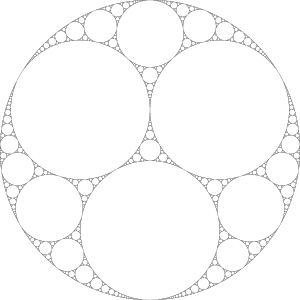
Apollonius' problem can be extended from the plane to the sphere and other quadratic surfaces. For the sphere, the problem is to construct all the circles (the boundaries of spherical caps) that are tangent to three given circles on the sphere.[24][40][41] This spherical problem can be rendered into a corresponding planar problem using stereographic projection. Once the solutions to the planar problem have been constructed, the corresponding solutions to the spherical problem can be determined by inverting the stereographic projection. Even more generally, one can consider the problem of four tangent curves that result from the intersections of an arbitrary quadratic surface and four planes, a problem first considered by Charles Dupin.[9]
By solving Apollonius' problem repeatedly to find the inscribed circle, the interstices between mutually tangential circles can be filled arbitrarily finely, forming an Apollonian gasket, also known as a Leibniz packing or an Apollonian packing.[42] This gasket is a fractal, being self-similar and having a dimension d that is not known exactly but is roughly 1.3,[43] which is higher than that of a regular (or rectifiable) curve (d = 1) but less than that of a plane (d = 2). The Apollonian gasket was first described by Gottfried Leibniz in the 17th century, and is a curved precursor of the 20th-century Sierpiński triangle.[44] The Apollonian gasket also has deep connections to other fields of mathematics; for example, it is the limit set of Kleinian groups.[45]
The configuration of a circle tangent to four circles in the plane has special properties, which have been elucidated by Larmor (1891)[46] and Lachlan (1893).[47] Such a configuration is also the basis for Casey's theorem,[17] itself a generalization of Ptolemy's theorem.[48]
The extension of Apollonius' problem to three dimensions, namely, the problem of finding a fifth sphere that is tangent to four given spheres, can be solved by analogous methods.[9] For example, the given and solution spheres can be resized so that one given sphere is shrunk to point while maintaining tangency.[49] Inversion in this point reduces Apollonius' problem to finding a plane that is tangent to three given spheres. There are in general eight such planes, which become the solutions to the original problem by reversing the inversion and the resizing. This problem was first considered by Pierre de Fermat,[50] and many alternative solution methods have been developed over the centuries.[51]
Apollonius' problem can even be extended to d dimensions, to construct the hyperspheres tangent to a given set of d + 1 hyperspheres.[52] Following the publication of Frederick Soddy's re-derivation of the Descartes theorem in 1936, several people solved (independently) the mutually tangent case corresponding to Soddy's circles in d dimensions.[53]
تطبيقات
The principal application of Apollonius' problem, as formulated by Isaac Newton, is hyperbolic trilateration, which seeks to determine a position from the differences in distances to at least three points.[8] For example, a ship may seek to determine its position from the differences in arrival times of signals from three synchronized transmitters. Solutions to Apollonius' problem were used in World War I to determine the location of an artillery piece from the time a gunshot was heard at three different positions,[9] and hyperbolic trilateration is the principle used by the Decca Navigator System and LORAN.[7] Similarly, the location of an aircraft may be determined from the difference in arrival times of its transponder signal at four receiving stations. This multilateration problem is equivalent to the three-dimensional generalization of Apollonius' problem and applies to global navigation satellite systems (see GPS#Geometric interpretation).[54] It is also used to determine the position of calling animals (such as birds and whales), although Apollonius' problem does not pertain if the speed of sound varies with direction (i.e., the transmission medium not isotropic).[55]
Apollonius' problem has other applications. In Book 1, Proposition 21 in his Principia, Isaac Newton used his solution of Apollonius' problem to construct an orbit in celestial mechanics from the center of attraction and observations of tangent lines to the orbit corresponding to instantaneous velocity.[9] The special case of the problem of Apollonius when all three circles are tangent is used in the Hardy–Littlewood circle method of analytic number theory to construct Hans Rademacher's contour for complex integration, given by the boundaries of an infinite set of Ford circles each of which touches several others.[56] Finally, Apollonius' problem has been applied to some types of packing problems, which arise in disparate fields such as the error-correcting codes used on DVDs and the design of pharmaceuticals that bind in a particular enzyme of a pathogenic bacterium.[57]
انظر أيضاً
- Apollonius point
- Apollonius' theorem
- Isodynamic point of a triangle
الهامش
- ^ أ ب Dörrie H (1965). "The Tangency Problem of Apollonius". 100 Great Problems of Elementary Mathematics: Their History and Solutions. New York: Dover. pp. 154–160 (§32).
- ^ أ ب ت ث Coxeter HSM (1 January 1968). "The Problem of Apollonius". The American Mathematical Monthly. 75 (1): 5–15. doi:10.2307/2315097. ISSN 0002-9890. JSTOR 2315097.
- ^ أ ب Coolidge JL (1916). A Treatise on the Circle and the Sphere. Oxford: Clarendon Press. pp. 167–172.
- ^ خطأ استشهاد: وسم
<ref>غير صحيح؛ لا نص تم توفيره للمراجع المسماةcoxeter greitzer - ^ Coxeter, HSM (1969). Introduction to Geometry (2nd ed.). New York: Wiley. ISBN 978-0-471-50458-0.
- ^ Needham, T (2007). Visual Complex Analysis. New York: Oxford University Press. pp. 140–141. ISBN 978-0-19-853446-4.
- ^ أ ب Hofmann-Wellenhof B, Legat K, Wieser M, Lichtenegger H (2003). Navigation: Principles of Positioning and Guidance. Springer. ISBN 978-3-211-00828-7.
- ^ أ ب Schmidt, RO (1972). "A new approach to geometry of range difference location". IEEE Transactions on Aerospace and Electronic Systems. AES-8 (6): 821–835. Bibcode:1972ITAES...8..821S. doi:10.1109/TAES.1972.309614. S2CID 51648067.
- ^ أ ب ت ث ج ح خ Althiller-Court N (1961). "The problem of Apollonius". The Mathematics Teacher. 54: 444–452.
- ^ Gabriel-Marie F (1912). Exercices de géométrie, comprenant l'exposé des méthodes géométriques et 2000 questions résolues (in الفرنسية). Tours: Maison A. Mame et Fils. pp. cc=umhistmath, rgn=full%20text, idno=ACV3924.0001.001, didno=ACV3924.0001.001, view=pdf, seq=00000048 18–20, cc=umhistmath, rgn=full%20text, idno=ACV3924.0001.001, didno=ACV3924.0001.001, view=pdf, seq=00000703 673–677.
- ^ أ ب Pappus (1876). F Hultsch (ed.). Pappi Alexandrini collectionis quae supersunt (in اللاتينية) (3 volumes ed.).
- ^ خطأ استشهاد: وسم
<ref>غير صحيح؛ لا نص تم توفيره للمراجع المسماةbruen_1983 - ^ van Roomen A (1596). Problema Apolloniacum quo datis tribus circulis, quaeritur quartus eos contingens, antea a…Francisco Vieta…omnibus mathematicis…ad construendum propositum, jam vero per Belgam…constructum (in latin). Würzburg: Typis Georgii Fleischmanni.
{{cite book}}: CS1 maint: unrecognized language (link) (in لاتينية) - ^ Newton I (1974). DT Whiteside (ed.). The Mathematical Papers of Isaac Newton, Volume VI: 1684–1691. Cambridge: Cambridge University Press. p. 164. ISBN 0-521-08719-8.
- ^ Newton I (1687). Philosophiæ Naturalis Principia Mathematica. Book I, Section IV, Lemma 16.
{{cite book}}: Unknown parameter|nopp=ignored (|no-pp=suggested) (help) - ^ Newton I (1974). DT Whiteside (ed.). The Mathematical Papers of Isaac Newton, Volume VI: 1684–1691. Cambridge: Cambridge University Press. pp. 162–165, 238–241. ISBN 0-521-08719-8.
- ^ أ ب Casey J (1886) [1881]. A sequel to the first six books of the Elements of Euclid. Hodges, Figgis & co. p. 122. ISBN 978-1-4181-6609-0.
- ^ Courant R, Robbins H (1943). What is Mathematics? An Elementary Approach to Ideas and Methods. London: Oxford University Press. pp. 125–127, 161–162. ISBN 0-19-510519-2.
- ^ Bold B (1982). Famous problems of geometry and how to solve them. Dover Publications. pp. 29–30. ISBN 0-486-24297-8.
- ^ Viète F. (1600). "Apollonius Gallus. Seu, Exsuscitata Apolloni Pergæi Περι Επαφων Geometria". In Frans van Schooten (ed.). Francisci Vietae Opera mathematica (in latin). ex officina B. et A. Elzeviriorum (Lugduni Batavorum) (published 1646). pp. 325–346.
{{cite book}}: CS1 maint: unrecognized language (link) (in لاتينية) - ^ Boyer CB, Merzbach UC (1991). "Apollonius of Perga". A History of Mathematics (2nd ed.). John Wiley & Sons, Inc. p. 322. ISBN 0-471-54397-7.
- ^ Simson R (1734) Mathematical Collection, volume VII, p. 117.
Zeuthen HG (1886). Die Lehre von den Kegelschnitten im Altertum (in الألمانية). Copenhagen: Unknown. pp. 381–383.
Heath TL. A History of Greek Mathematics, Volume II: From Aristarchus to Diophantus. Oxford: Clarendon Press. pp. 181–185, 416–417. - ^ Poncelet J-V (January 1811). "Solutions de plusieurs problêmes de géométrie et de mécanique". Correspondance sur l'École Impériale Polytechnique (in الفرنسية). 2 (3): 271–273.
- ^ أ ب Gergonne J (1813–1814). "Recherche du cercle qui en touche trois autres sur une sphère". Ann. Math. Pures Appl. (in الفرنسية). 4.
- ^ Petersen J (1879). Methods and Theories for the Solution of Problems of Geometrical Constructions, Applied to 410 Problems. London: Sampson Low, Marston, Searle & Rivington. pp. 94–95 (Example 403).
- ^ أ ب ت ث Zlobec BJ, Kosta NM (2001). "Configurations of Cycles and the Apollonius Problem". Rocky Mountain Journal of Mathematics. 31 (2): 725–744. doi:10.1216/rmjm/1020171586.
- ^ Euler L (1790). "Solutio facilis problematis, quo quaeritur circulus, qui datos tres circulos tangat" (PDF). Nova Acta Academiae Scientiarum Imperialis Petropolitinae (in اللاتينية). 6: 95–101. Reprinted in Euler's Opera Omnia, series 1, volume 26, pp. 270–275.
- ^ Gauss CF (1873). Werke, 4. Band (in الألمانية) (reprinted in 1973 by Georg Olms Verlag (Hildesheim) ed.). Göttingen: Königlichen Gesellschaft der Wissenschaften. pp. 399–400. ISBN 3-487-04636-9.
- ^ Carnot L (1801). De la corrélation dans les figures de géométrie (in الفرنسية). Paris: Unknown publisher. pp. No. 158–159.
Carnot L (1803). Géométrie de position (in الفرنسية). Paris: Unknown publisher. pp. 390, §334. - ^ Cauchy AL (July 1806). "Du cercle tangent à trois cercles donnés". Correspondance sur l'École Polytechnique (in الفرنسية). 1 (6): 193–195.
- ^ خطأ استشهاد: وسم
<ref>غير صحيح؛ لا نص تم توفيره للمراجع المسماةknight_2005 - ^ Milorad R. Stevanovic, Predrag B. Petrovic, and Marina M. Stevanovic, "Radii of circles in Apollonius' problem", Forum Geometricorum 17 (2017), 359–372: Theorem 1. http://forumgeom.fau.edu/FG2017volume17/FG201735.pdf
- ^ Eppstein D (1 January 2001). "Tangent Spheres and Triangle Centers". The American Mathematical Monthly. 108 (1): 63–66. arXiv:math/9909152. doi:10.2307/2695679. ISSN 0002-9890. JSTOR 2695679. S2CID 14002377.
- ^ Oldknow A (1 April 1996). "The Euler–Gergonne–Soddy Triangle of a Triangle". The American Mathematical Monthly. 103 (4): 319–329. doi:10.2307/2975188. ISSN 0002-9890. JSTOR 2975188.
Weisstein, EW. "Four Coins Problem". MathWorld. Retrieved 2008-10-06. - ^ Descartes R, Œuvres de Descartes, Correspondance IV, (C. Adam and P. Tannery, Eds.), Paris: Leopold Cert 1901. (in فرنسية)
- ^ أ ب Beecroft H (1842). "Properties of Circles in Mutual Contact". The Lady's and Gentleman's Diary. 139: 91–96.
Beecroft H (1846). "Unknown title". The Lady's and Gentleman's Diary: 51. (MathWords online article Archived 2008-01-18 at the Wayback Machine) - ^ أ ب Steiner J (1826). "Einige geometrische Betrachtungen". Journal für die reine und angewandte Mathematik. 1: 161–184, 252–288. doi:10.1515/crll.1826.1.161. S2CID 122065577.
- ^ Soddy F (20 June 1936). "The Kiss Precise". Nature. 137 (3477): 1021. Bibcode:1936Natur.137.1021S. doi:10.1038/1371021a0.
- ^ Pedoe D (1 June 1967). "On a theorem in geometry". Amer. Math. Monthly. 74 (6): 627–640. doi:10.2307/2314247. ISSN 0002-9890. JSTOR 2314247.
- ^ Carnot L (1803). Géométrie de position. Paris: Unknown publisher. pp. 415, §356.
- ^ Vannson (1855). "Contact des cercles sur la sphère, par la geométrie". Nouvelles Annales de Mathématiques (in الفرنسية). XIV: 55–71.
- ^ Kasner E, Supnick F (December 1943). "The Apollonian Packing of Circles". Proc. Natl. Acad. Sci. USA. 29 (11): 378–384. Bibcode:1943PNAS...29..378K. doi:10.1073/pnas.29.11.378. ISSN 0027-8424. PMC 1078636. PMID 16588629.
- ^ Boyd DW (1973). "Improved Bounds for the Disk Packing Constants". Aequationes Mathematicae. 9: 99–106. doi:10.1007/BF01838194. S2CID 121089590.
Boyd DW (1973). "The Residual Set Dimension of the Apollonian Packing". Mathematika. 20 (2): 170–174. doi:10.1112/S0025579300004745.
McMullen, Curtis T (1998). "Hausdorff dimension and conformal dynamics III: Computation of dimension" (PDF). American Journal of Mathematics. 120 (4): 691–721. doi:10.1353/ajm.1998.0031. S2CID 15928775. - ^ Mandelbrot B (1983). The Fractal Geometry of Nature. New York: W. H. Freeman. p. 170. ISBN 978-0-7167-1186-5.
Aste T, Weaire D (2008). The Pursuit of Perfect Packing (2nd ed.). New York: Taylor and Francis. pp. 131–138. ISBN 978-1-4200-6817-7. - ^ Mumford D, Series C, Wright D (2002). Indra's Pearls: The Vision of Felix Klein. Cambridge: Cambridge University Press. pp. 196–223. ISBN 0-521-35253-3.
{{cite book}}: CS1 maint: multiple names: authors list (link) - ^ Larmor A (1891). "Contacts of Systems of Circles". Proceedings of the London Mathematical Society. 23: 136–157. doi:10.1112/plms/s1-23.1.135.
- ^ Lachlan R (1893). An elementary treatise on modern pure geometry. London: Macmillan. pp. §383–396, pp. 244–251. ISBN 1-4297-0050-5.
- ^ خطأ استشهاد: وسم
<ref>غير صحيح؛ لا نص تم توفيره للمراجع المسماةjohnson_1929 - ^ خطأ استشهاد: وسم
<ref>غير صحيح؛ لا نص تم توفيره للمراجع المسماةogilvy_1969 - ^ de Fermat P, Varia opera mathematica, p. 74, Tolos, 1679.
- ^ Euler L (1810). "Solutio facilis problematis, quo quaeritur sphaera, quae datas quatuor sphaeras utcunque dispositas contingat" (PDF). Mémoires de l'Académie des Sciences de St.-Pétersbourg (in اللاتينية). 2: 17–28. Reprinted in Euler's Opera Omnia, series 1, volume 26, pp. 334–343.
Carnot L (1803). Géométrie de position (in الفرنسية). Paris: Imprimerie de Crapelet, chez J. B. M. Duprat. pp. 357, §416.
Hachette JNP (September 1808). "Sur le contact des sphères; sur la sphère tangente à quatre sphères données; sur le cercle tangent à trois cercles donnés". Correspondance sur l'École Polytechnique (in الفرنسية). 1 (2): 27–28.
Français J (January 1810). "De la sphère tangente à quatre sphères données". Correspondance sur l'École Impériale Polytechnique (in الفرنسية). 2 (2): 63–66.
Français J (January 1813). "Solution analytique du problème de la sphère tangente à quatre sphères données". Correspondance sur l'École Impériale Polytechnique (in الفرنسية). 2 (5): 409–410.
Dupin C (January 1813). "Mémoire sur les sphères". Correspondance sur l'École Impériale Polytechnique (in الفرنسية). 2 (5): 423.
Reye T (1879). Synthetische Geometrie der Kugeln (PDF) (in الألمانية). Leipzig: B. G. Teubner.
Serret JA (1848). "De la sphère tangente à quatre sphères donnèes". Journal für die reine und angewandte Mathematik. 37: 51–57. doi:10.1515/crelle-1848-18483704. S2CID 201061558.
Coaklay GW (1859–1860). "Analytical Solutions of the Ten Problems in the Tangencies of Circles; and also of the Fifteen Problems in the Tangencies of Spheres". The Mathematical Monthly. 2: 116–126.
Alvord B (1 January 1882). "The intersection of circles and intersection of spheres". American Journal of Mathematics. 5 (1): 25–44, with four pages of Figures. doi:10.2307/2369532. ISSN 0002-9327. JSTOR 2369532.
- ^ خطأ استشهاد: وسم
<ref>غير صحيح؛ لا نص تم توفيره للمراجع المسماةdreschler sterz - ^ Gossett T (1937). "The Kiss Precise". Nature. 139 (3506): 62. Bibcode:1937Natur.139Q..62.. doi:10.1038/139062a0.
- ^ Hoshen J (1996). "The GPS Equations and the Problem of Apollonius". IEEE Transactions on Aerospace and Electronic Systems. 32 (3): 1116–1124. Bibcode:1996ITAES..32.1116H. doi:10.1109/7.532270. S2CID 30190437.
- ^ Spiesberger, JL (2004). "Geometry of locating sounds from differences in travel time: Isodiachrons". Journal of the Acoustical Society of America. 116 (5): 3168–3177. Bibcode:2004ASAJ..116.3168S. doi:10.1121/1.1804625. PMID 15603162.
- ^ Apostol TM (1990). Modular functions and Dirichlet series in number theory (2nd ed.). New York: Springer-Verlag. ISBN 978-0-387-97127-8.
- ^ Lewis RH, Bridgett S (2003). "Conic Tangency Equations and Apollonius Problems in Biochemistry and Pharmacology". Mathematics and Computers in Simulation. 61 (2): 101–114. CiteSeerX 10.1.1.106.6518. doi:10.1016/S0378-4754(02)00122-2.
للاستزادة
- Boyd, DW (1973). "The osculatory packing of a three-dimensional sphere". Canadian Journal of Mathematics. 25 (2): 303–322. doi:10.4153/CJM-1973-030-5.
- Callandreau, Édouard (1949). Célèbres problèmes mathématiques (in الفرنسية). Paris: Albin Michel. pp. 219–226. OCLC 61042170.
- Camerer, JG (1795). Apollonii de Tactionibus, quae supersunt, ac maxime lemmata Pappi, in hos libros Graece nunc primum edita, e codicibus manuscriptis, cum Vietae librorum Apollonii restitutione, adjectis observationibus, computationibus, ac problematis Apolloniani historia (in اللاتينية). Gothae: Ettinger.
- Gisch D, Ribando JM (2004). "Apollonius' Problem: A Study of Solutions and Their Connections" (PDF). American Journal of Undergraduate Research. 3: 15–25. doi:10.33697/ajur.2004.010.
- Pappus of Alexandria (1933). Pappus d'Alexandrie: La collection mathématique (in الفرنسية). Paris. OCLC 67245614.
{{cite book}}: CS1 maint: location missing publisher (link) Trans., introd., and notes by Paul Ver Eecke. - Simon, M (1906). Über die Entwicklung der Elementargeometrie im XIX. Jahrhundert (in الألمانية). Berlin: Teubner. pp. 97–105.
- Wells, D (1991). The Penguin Dictionary of Curious and Interesting Geometry. New York: Penguin Books. pp. 3–5. ISBN 0-14-011813-6.
وصلات خارجية
- "Ask Dr. Math solution". Mathforum. Retrieved 2008-05-05.
- Eric W. Weisstein, Apollonius' problem at MathWorld.
- "Apollonius' Problem". Cut The Knot. Retrieved 2008-05-05.
- Kunkel, Paul. "Tangent Circles". Whistler Alley. Retrieved 2008-05-05.
- Austin, David (March 2006). "When kissing involves trigonometry". Feature Column at the American Mathematical Society website. Retrieved 2008-05-05.
- CS1 الفرنسية-language sources (fr)
- CS1 اللاتينية-language sources (la)
- Articles with لاتينية-language sources (la)
- CS1 errors: unsupported parameter
- CS1 الألمانية-language sources (de)
- Articles with فرنسية-language sources (fr)
- CS1: Julian–Gregorian uncertainty
- Articles containing Greek-language text
- Articles with hatnote templates targeting a nonexistent page
- CS1 maint: location missing publisher
- هندسة امتثالية
- هندسة إقليدية مستوية
- Incidence geometry
- History of geometry
